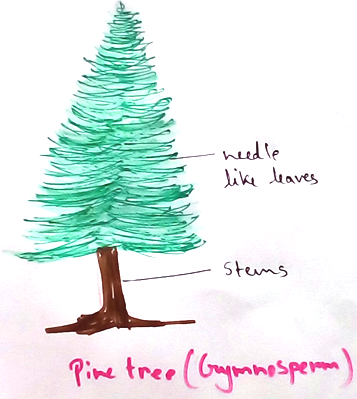Gymnosperms
Gymnos = naked and sperma = seed. So, it means naked seeded plant. The term Gymnosperms was first introduced Theophrastus in 300 B.C. in his book “Enquiry into Plants” but Robert Brown in 1827 recognized the group that –female flowers of Cycads and conifers are actually naked ovule. Tallest gymnosperms and the father of the forest Sequoiadendron giganteum. Cycas and Ginkgo represent a large group of plants and possesses trait of extinct pteridosperms and other gymnosperms. So, they are called living fossil.
Characteristics of gymnosperms are follows-
• The plants are perennial that forming a dominant flora in colder areas though their number is very small, hardly 900 species. It is due to their evergreen habits.
• Leaves are generally dimorphic, foliage and scale leaves.
• The foliage leaves do not have lateral veins. Instead, transfusion tissue (hydrostereom) occurs internally for lateral transport.
• Sporophylls produce strobili or cones. Flowers are absent.
• Microsporophylls do not show distinction of filament and anther. Megasporophylls are also not rolled like carpels.
• Ovules are unitegmic (apparently bitegmic in Gnetum). The integument is three layered. Ovules are attached to megasporophylls but are not covered by them. Each ovule has a mass of tissue which is called nucleus. It is equivalent to megasporangium. A megaspore mother cell develops in it.
• Female gametophyte develops archegonium. Neck canal cell is absent.
• Pollination brings pollen grains over the micropylar end of ovules (direct pollination). Siphonogamy occurs. Pollen tubes are primarily haustorial in nature.
• Endosperm is gametophyte. Endosperm tissue is formed before fertilization and therefore not equivalent to angiosperms where it is formed after fertilization. Full embryonic development may take place after shedding to the ground.
• Secondary growth is present in some gymnosperms. Vascular tissues are otherwise similar to those of pteridophytes with vessel present in Gnetales.
• Annual and herbaceous forms are absent.
• Wood pycnoxylic or manoxylic always with secondary vascular tissues, vascular tissues consisting of tracheids (vessels in few plants), and sieve cells.
Types of gymnosperms: According to the characteristics gymnosperms can be divided into-
1. Cycads - Example of cycads is Cycas.
2. Conifers - Example of conifers are Pinus.
3. Ginkgophyte - Examples are Ginkgo or Maiden Hair tree.
4. Gnetophyte – Examples of gnetophyte are Gnetum and Ephedra.
Economic importance of gymnosperms:
(i) Canada balsam is extracted from Abies balsamea . which is used as mounting agent for different parts of the plants.
(ii) Wood is soft and used in manufacturer of paper and timber.
(iii) Ephedrine is extracted from stem of Ephedra which is used as antiasthmatic drug.
(iv) Stem of cycas is a source of sago which is called Sago palm.
(v) Resin is present in some Pinus and some other conifers which is distilled to form rosin and turpentine.
(vi) Cedarwood oil is extracted from Juniperus virginiana. which is used in different purpose.
(vii) Pinus gerardiana used as edible seeds.
Questions and answers on Gymnosperms:
1. Name two parasitic gymnosperms.
Parasitaxus ustus is a parasite on Falcatifolium taxoides .
Gnetum trinerve is a parasite in Cinchona forests of Chimborazo.
2. Name an epiphytic gymnosperms.
Zamia pseudoparasitica is the only gymnosperms that grows as an epiphyte.
Recent Articles
-
What Is Plasma? | Blood Plasma | Proteins | Nutrients | Cholesterol
Nov 07, 25 10:29 AM
Blood is a mobile fluid which is a connective tissue and is derived from the mesoderm like cell any other connective tissue. Colour of blood is reddish and that flows inside the blood vessels by means… -
Disorders of Respiratory System | Tuberculosis | Pleurisy | Emphysema
Oct 28, 25 11:39 PM
Tuberculosis is very common disease and is caused by a type of bacteria called Mycobacterium tuberculosis. This disease causes different trouble in the respiration and infection of several parts of th… -
Regulation of Respiration | Respiratory Centres | Inspiratory Area |
Oct 14, 25 12:13 AM
Respiratory Centre is the area that controls the rate of respiration and it is observed to be located in medulla oblongata and pons. Respiratory Centre has the following will dispersed components like… -
Explain Transport of Gases | External Respiration | Tissue Respiration
Oct 09, 25 11:35 PM
In humans gaseous exchange is completed in the following ways the steps are - External Respiration or Breathing - Breathing in false taking in of Oxygen and giving out of carbon dioxide in the body. M… -
Kind and Number of Teeth | Location of Teeth in Mouth | Care of Teeth
Sep 11, 25 12:52 AM
Kind and Number of Teeth







New! Comments
Have your say about what you just read! Leave me a comment in the box below.